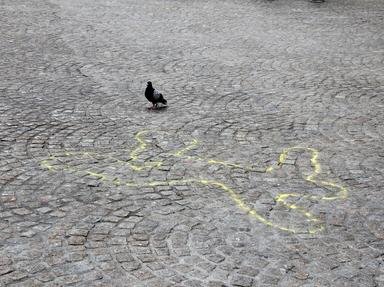Quiz Answer Key and Fun Facts
1. The bodies of Sharon Tate Polanski and four others were discovered at 10050 Cielo Drive on August 9, 1969. Winifred Chapman, the Polanskis' housekeeper, made the shocking find. When asked by police who was on the property, the hysterical Chapman could only rattle off three names. What names did she give police?
2. By 9:35 a.m., three West Los Angeles patrol units were at the crime scene. Why did the first officers on the scene not enter the Polanski residence through the front door?
3. A "possible" bloody fingerprint left on the button of the front gate mechanism at Cielo Drive, might have provided a clue to the killer's identity. Which officer destroyed the print by activating the gate?
4. When interviewed years later, what did DeRosa say was the only sound he could recall, as he approached the Polanski residence for the first time?
5. The Tate murders were front page news all across the country. The August 10, 1969 edition of The San Francisco Sunday Examiner and Chronicle featured the headline, "Hollywood Shocker." Whose photo(s) appeared under the headline?
6. Approximately how much time passed between the police discovery of the Tate victims and that of the LaBianca victims?
7. After the discovery of the LaBianca victims, police were quick to point out that these murders were in no way connected to the Cielo Drive murders, because of the distance between the two crime scenes.
8. How much was offered as a reward for information leading to the arrest of those responsible for the Tate murders?
9. Unlike the "Tate Homicide Progress Report" of October 22, 1969, which listed numerous suspects, the "LaBianca Homicide Report" of October 15, 1969, named only three suspects, two of which were the LaBianca children.
10. On December 1, 1969, LAPD Chief Edward Davis, announced that the Tate murders had been solved. Who were arrest warrants issued for?
11. Charles Manson did not know the identity of any of the Cielo Drive residents he would later order killed.
12. After Susan Atkins reneged on her deal to testify for the prosecution, Linda Kasabian offered to tell all she knew, if granted full immunity.
13. On March 3, 1970, Linda Kasabian, accompanied by Gary Fleischman, Deputy District Attorney Vincent Bugliosi and a dozen LAPD officers, visited 10050 Cielo Drive, scene of the Tate murders. As she approached the gate, what caused Kasabian to burst into tears?
14. The trial of the Manson defendants began on July 24, 1970. Who was the prosecution's first witness?
15. William Garretson, who resided in the guesthouse at 10050 Cielo Drive, was the fourth witness called by the prosecution. His testimony was brief, as he swore under oath that he had neither seen nor heard anything unusual the night of the murders. In the years since the murders, he has rarely spoken about the events of that night. However, in a 1999 television interview, how did Garretson remember the early morning hours of August 9, 1969?
16. Linda Kasabian, former Manson disciple turned star prosecution witness, was on the stand for eighteen days. What, if any, criminal charges was she facing as she took the witness stand?
17. Who made an unexpected appearance in court, the afternoon of September 18, 1970?
18. What significant event took place on September 26, 1970?
19. According to Manson, what does "Helter Skelter" mean?
20. How much time did Irving Kanarek, attorney for Charles Manson, spend on his closing argument?
21. How long were the jury deliberations in the guilt phase of the trial?
22. Once court resumed, how long did the clerk take in reading the verdicts against Atkins, Krenwinkle, Manson and Van Houten?
23. The verdicts came as no surprise to the Manson defense attorneys. However, Patricia Krenwinkle's counsel was clearly upset. According to Paul Fitzgerald, when was the case lost?
24. Dr. Joel Hochman, in a psychiatric report to the court, stated of this convicted Manson disciple, "I have very little hope for their eventual rehabilitation." Who was Hochman referring to?
25. Since their convictions in 1971, none of the Tate/LaBianca murderers have been freed.
Source: Author
ripper1
This quiz was reviewed by FunTrivia editor
DakotaNorth before going online.
Any errors found in FunTrivia content are routinely corrected through our feedback system.

